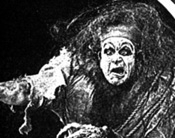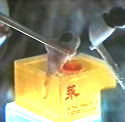
Promise of Science: Man-Made Life

<< previous theme (robots) |
| The role that man made life plays in science fiction film is often similar to the role that robots play, as some of the same moral conclusions are drawn. Most often, man creates (or modifies) biological life and has to deal with the repercussions. Issues raised include the definition of what makes an entity human (or not), the morality of experimentation, and the consequences of changing or creating life. | |||
|
|||
|
Homunculus (Die Rache Des Homunkulus) (1916, Germany) is a significant Frankenstein-inspired movie, where a monster is created in the image of man and is both intellectually and morally proper. Homonculus functions normally in human society, until he discovers that it was created and not born naturally. Since he is stronger than most humans, he has little trouble establishing himself as a ruthless dictator of mankind. He is eventually stopped by lightening. Homunculus is the longest film of this type yet, running 401 minutes in 6 parts. |
|||
|
Island of Lost Souls (1933, US) also emphasized the wrongness of meddling with life. Instead of one creature made in the image of man, this film features a whole island full of man-like creatures created from animals. Dr. Moreau is a renegade scientist whose life's work involves surgically changing animals into animal-like humans. He has enslaved them on his island, and in typical mad scientist style, is ruthless and hurtful to his creations. A man lands on the island, and discovers what has been happening there. Sick of being mistreated and upset about their questionable origins, the enslaved creatures rebel against their master. |
|||
|
|||
|
A deadly virus that eradicates most of the population of the planet is the artificial life created in Twelve Monkeys (1995, US). Despite the importance of the virus to this film's story, we never learn a great deal about it. It was manufactured during the 1990s, probably by Goines' father. This is the only person we know of who is capable of creating it. When it was first released in 1996, everybody thought that it was some kind of flu -- until people started dying and no cure could counter it. The scientists of 2035 are attempting to learn about the virus by collecting specimens of other animals who have survived the plague. Although we never see these scientists in action, what we do see of their science (the inaccurate time travel machine, questionable ethics, and antiquated equipment) suggests that they will probably not get too far in their quest to create a cure. |
|||
Life created by humans generally causes more problems than it solves. It is difficult to control artificial intelligence, and morally wrong to enslave another living creature. Each of these films warns about these dangers in a unique way, and explores the reprecussions of creating artificial life. |
<< previous theme (robots) |


. last modified: Jul 20, 2000 .

